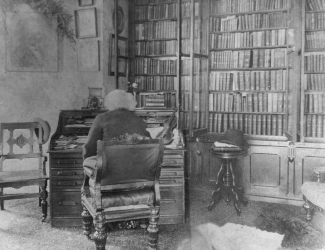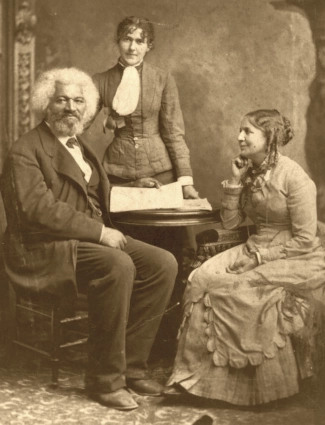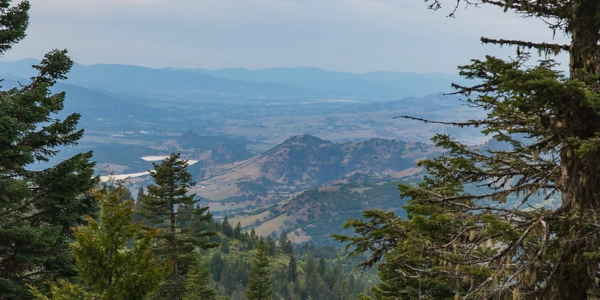
Image above: Frederick Douglass, 1879, Frank W. Legg Photographic Collection. Courtesy National Archives.
Spotlight on Lesser Known History
Frederick Douglass NHS, D.C.
America's Best History Spotlight
On this page we're going to Spotlight the lesser known historic sites and attractions that dot the history landscape across the USA and are worth a visit if you're in their area. And while they may be lesser known, some are very unique, and will be that rare find. You'll be, at times, on the ground floor, or maybe even know something others don't. It'll be fun. Visit them.

Frederick Douglass National Historic Site, District of Columbia
By the time Frederick Douglass and his family had moved into the Cedar Hill mansion in Anacostia, he had already risen to fame as the Civil Rights advocate of the day. Three years after he escaped from slavery in 1838, he was encouraged to become an anti-slavery lecturer. In 1845, Douglass wrote his first autobiography and began to gain wealth, selling 11,000 copies of "Narrative of the Life of Frederick Douglass, an American Slave." By 1847, between the book and his speaking engagements against slavery, Douglass had become well known, but also accosted for his beliefs. He had become disatisfied with the nation as a whole. "I have no love for America, as such; I have no patriotism. I have no country. What country have I? The Institutions of this Country do not know me - do not recognize me as a man." Image above: Cedar Hill, Frederick Douglass National Historic Site, 1977. Courtesy Library of Congress via Wikipedia Commons.
Sponsor this page for $100 per year. Your banner or text ad can fill the space above.
Click here to Sponsor the page and how to reserve your ad.
Info, What's There Now, History Nearby

Frederick Douglass NHS, D.C.
At this time he began to travel the world, gaining additional fame in England and Ireland, returning in 1847 to begin publishing his first abolitionist newspaper, the North Star, and attending events on Women's Suffrage. By 1859, Douglass had become so disatisfied with the progress of either movement, that he met with John Brown about his raid at Harpers Ferry. Douglass, however, backed out, thinking success there as impossible.
Once Civil War broke out, Douglass continued his advocacy that an outcome of the war would bring freedom and equal rights on race and sex. Two of his sons fought for the 54th Massachusetts Infantry Regiment, and when Douglass thought that black soldiers were being mistreated on pay and conditions, he met with President Abraham Lincoln to alter their treatment.
For more than ten years after the war, Douglass fought alongside abolitionist politicians to insure that the 13th, 14th, and 15th Amendments were written and enacted. He did, however, abandon the subject of Women's Suffrage in deference to the freedom issues of black citizens.
It was not until 1872 that Frederick and Anna Murray Douglass moved their family to Washington, then into the house on Cedar Hill in 1877. Three of his sons were already Washington residents, and Douglass was in line to take up government positions; Assistant Secretary of the Santo Domingo Commission, Council member of the D.C. Territorial Government, on the board at Howard University, and became president of the Freedman's Bank.
Image above: Mural of Frederick Douglas imploring President Lincoln to allow black soldiers to fight in the Union Army under the same condition and pay as white soldiers, 1943, William Edouard Scott, Recorder of Deeds Building. Photo by Carol M. Highsmith. Courtesy Library of Congress. Below: Cedar Hill, Frederick Douglass home in Washington, D.C., 1980/2006, Carol M. Highsmith. Courtesy Library of Congress.

Where Is It
The Frederick Douglass National Monument is located on the east side of the Anacostia River from downtown Washington, D.C. The mansion sits atop a hill, Cedar Hill. Its address is 1411 W Street SE, Washington, DC, 20020. Both the visitor center and free parking lot are at the bottom of the hill below the mansion.
What is There Now
Frederick Douglass National Historic Site
The Cedar Hill home, Visitor Center, and grounds in the Anacostia section of Washington, D.C. recounts the days of Frederick Douglass as he spent his time writing and advocating for Civil Rights with the dignitaries of the day. The only way to tour the mansion is by a guided tour.
When Open and How Much
The Cedar Hill home is usually open for guided ranger tours, although that has not been the case since the pandemic. The grounds are open on Friday and Saturday with park staff on hand to answer questions. Entrance is free of charge. If you want a reservation to tour the house, when reopened, it is $1.00. School groups upon reopening $10.00.
Fees subject to change.
Websites
Frederick Douglass National Historic Site
History Nearby
For the Washington area native, or well traveled visitor, they know just how much history surrounds D.C., as well as within. Naming just a few; the National Mall with all those monuments, Mount Vernon with the story of George Washington, and Manassas, the first major land battle of the Civil War, etc. You can make a day of it or weeks.
Buy Chronology

Great Book for the History Fan with Fifty Short Essays Telling the Story of American History.
Photos, History, and More Spotlights

Upbringing and Escape
The man we know now as Frederick Douglass had been born in 1818 as a slave on the eastern shore of Maryland as Frederick Augustus Washington Bailey, of mixed race, and did not know his father, and barely knew his mother. He was raised by his maternal grandmother, a slave, and maternal grandfather, who was free. He was separated from his grandparents when he was six. At the Auld plantation where he was then raised, he began to be taught to read by the plantation owner's wife, before that teaching was banned by the husband, then continued to learn by himself. He was shuttled about to other plantations in his teens, finally confronting an itinerant farmer who had beaten him. After Douglass confronted that men, he was never beaten again. "You have seen how a man was made a slave; you shall see how a slave was made a man."
When he escaped himself at twenty years old, September 3, 1838, with the assistance of Anna Murray, a free woman who would later become his wife for forty-four years, by boarding a train of the Philadelphia, Wilmington, and Baltimore Railroad. He was dressed in a sailor's uniform and carried the identification of a free black seamen. His journey continued north through Philadelphia to New York City to the house of noted abolitionist David Ruggles.
Photo above: Frederick Douglass in his library and study at Cedar Hill. Courtesy National Park Service.

Reconstruction Efforts
After the death of Abraham Lincoln, Douglass worked tirelessly on the topic of Reconstruction, as well as rekindling his efforts on equality for both blacks and women. He met with new President Andrew Johnson on the topic just as the rise of the Klan began, becoming to most a military arm of the Democratic Party as they tried to regain control of southern offices. To combat this, Douglass supported U.S. Grant for President in 1868, and with his support, Grant signed the Civil Rights Act of 1871, and attempted to tamp down Klan activities in the south through the Enforcement Acts.
Douglass and wife Anna lived in the Cedar Hill estate for eleven years before Anna's passing in 1882. Douglass remarried two years later to abolitionist and suffragist Helen Pitts.
Photo above: Frederick Douglass with his second wife Helen Pitts Douglass (seated) and her sister Eva Pitts standing behind them, 1880, photographer unknown. Courtesy National Park Service via Wikipedia Commons.

Museum on Cedar Hill
After Douglass passed in 1895, Helen Pitts devoted her time to making the Cedar Hill home a museum to her husband's accomplishments, starting one year later to gain support from others to insure its continuation as a historic site devoted to the legacy of Frederick Douglass. It has been open as a memorial and historic site now for more than one century.
The home has been restored many times over the years; first in 1922, then in 1938 by the National Youth Administration and the Works Progress Administration. In 1962, President Kennedy signed a bill purchasing the site and making it part of the National Park Service. After ten years of reconstruction, the home was again open to the public on February 14, 1972.
Photo above: Art depicting a southern plantation at Cedar Hill, the home of Frederick Douglass, date and author unknown. Courtesy Carol M. Highsmith photo collection at the Library of Congress.

T-Shirts and Gifts from the official souvenirs of Americasbesthistory.com.
About
America's Best History where we take a look at the timeline of American History and the historic sites and national parks that hold that history within their lands.
Photos courtesy of the Library of Congress, National Archives, National Park Service, americasbesthistory.com and its licensors.
- Contact Us
- About
- © 2022 Americasbesthistory.com.
Template by w3layouts.


